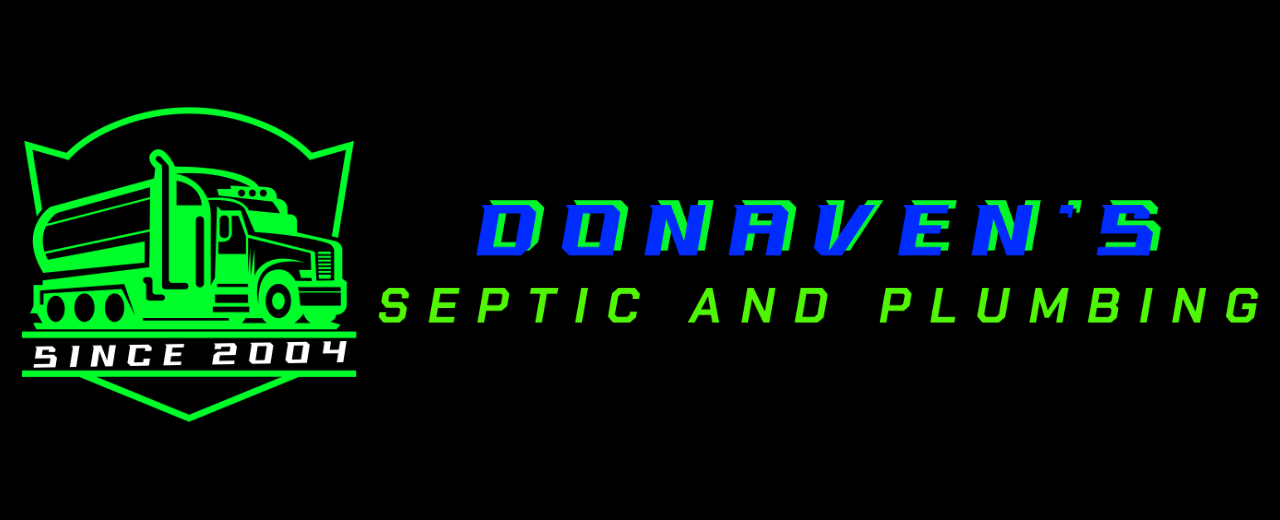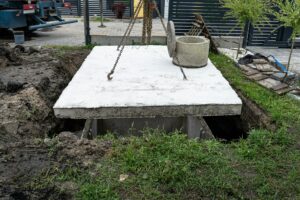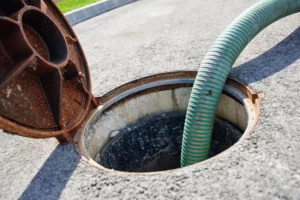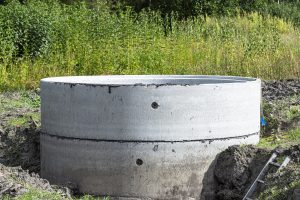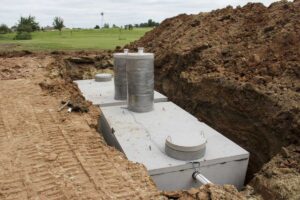An aerobic septic system treats wastewater using oxygen, making it more efficient than traditional methods. This article explains how they work, their benefits, and how to maintain them effectively.
Key Takeaways
- Aerobic septic systems utilize forced aeration to promote aerobic bacteria growth, leading to more efficient waste decomposition and cleaner effluent compared to traditional systems.
- Regular maintenance, including inspections and a proper pumping schedule every 3-5 years, is essential to prevent costly repairs and ensure optimal system operation.
- Using high-efficiency appliances and proper disposal practices significantly reduces water usage and strain on the system, helping maintain its longevity and effectiveness.
Understanding Aerobic Septic Systems
Aerobic septic systems are advanced on-site wastewater treatment solutions that operate through multi-stage processes using forced aeration. Unlike traditional septic systems that rely on anaerobic bacteria, aerobic systems introduce oxygen to promote the growth of aerobic bacteria, which decompose waste more efficiently.
Regular maintenance helps prevent costly repairs and ensures the system operates effectively.
How Aerobic Systems Work
Aerobic septic systems operate by introducing air into the wastewater through an Aerobic Treatment Unit (ATU). This process creates an oxygen-rich environment that supports the growth of aerobic bacteria, which are highly efficient at decomposing organic waste. In the aeration stage, air is forced into the tank, allowing these bacteria to thrive and break down waste rapidly, resulting in cleaner effluent.
The benefits of this process are manifold. Not only do aerobic bacteria consume organic waste more efficiently than their anaerobic counterparts, but the cleaner effluent produced poses a lower risk to the environment. This oxygen-driven treatment ensures that the treated wastewater released into the environment is much safer, reducing the likelihood of contamination and other environmental hazards.
Key Components
Understanding the key components of an aerobic septic system is vital for effective maintenance and operation. The system begins with the Trash Tank, which separates solids from liquid wastewater in the septic tank. This stage is crucial as it prevents larger debris from entering subsequent treatment stages, ensuring smoother operation.
Following this is the aeration chamber, where the magic happens. This chamber is essential as it allows aerobic bacteria to process the wastewater effectively.
Finally, the clarification chamber separates any remaining solids from the treated water, leading to a clearer and safer effluent. Each of these components plays a critical role in ensuring the system functions efficiently and effectively.
Benefits of Aerobic Systems
Aerobic septic systems offer several advantages over traditional septic systems and conventional septic system options. Creating oxygen-rich environments enhances the rapid breakdown of organic matter, making wastewater treatment more efficient. The use of mechanical components in these systems ensures that the waste is broken down thoroughly, reducing the risk of environmental contamination.
Moreover, the addition of natural bacteria and enzyme additives can further boost the efficiency of aerobic systems. Using calcium hypochlorite tablets aids in maintaining water quality, ensuring that the treated wastewater is of high quality.
These benefits make aerobic septic systems a superior choice for modern wastewater management.
Essential Maintenance Practices
Regular maintenance is the cornerstone of avoiding costly repairs and extending the lifespan of an aerobic septic system. Neglecting maintenance can lead to system failures and expensive repairs. Professional services for routine checks help identify and address potential issues promptly, preventing larger and costlier repairs.
Regular Inspections
Regular inspections are critical to the health of your aerobic septic system. During these inspections, professionals assess the overall condition of the system, including checking for leaks, scum, and sludge levels. These inspections are not just about spotting problems but also about ensuring that the system complies with local regulations and operates safely.
Certified professionals should conduct these inspections. They have the expertise to detect issues that might go unnoticed by an untrained eye. These inspections help maintain system efficiency and longevity, avoiding future costly repairs.
Pumping Schedule
A proper pumping schedule is fundamental to maintaining the system’s functionality. Regular pumping, typically recommended every 3-5 years, helps prevent system overflows and failures. Adhering to this schedule ensures that solids do not accumulate to levels that could disrupt the system’s operation.
Neglecting recommended pumping intervals can lead to severe consequences. System overflows not only lead to environmental contamination but can also result in significant repair costs. Regular pump-outs ensure smooth operation and efficient wastewater treatment, particularly when utilizing a pump tank.
Cleaning and Additives
Proper cleaning and additives are crucial for maintaining the system. Harsh chemicals should be avoided as they can disrupt beneficial bacteria. Spreading laundry loads throughout the week helps the system recover between uses, preventing overloads.
Using additives like calcium hypochlorite tablets helps maintain water quality and boost efficiency.
Water Usage Tips
Water conservation is key to preventing overwhelming your aerobic septic system. Excessive water usage can lead to operational issues, as the system’s capacity can be exceeded. Water-saving practices reduce the volume of wastewater needing processing, ensuring efficient system function.
High-Efficiency Appliances
One of the most effective ways to reduce water usage is by installing high-efficiency appliances. High-efficiency toilets, for instance, use significantly less water per flush compared to older models. Modern low-flow toilets can save up to 27,000 gallons of water annually, which helps mitigate water usage and prevents system overload.
High-efficiency appliances throughout your home can make a substantial difference. This practice helps avoid costly repairs by reducing strain on your septic system and contributes to water conservation.
Proper Disposal Practices
Proper disposal practices maintain the health of your aerobic septic system. Avoid bleach or strong household cleaners as they can disrupt essential microorganisms. Instead, opt for septic-safe products that do not harm beneficial bacteria.
Flushing non-biodegradable items leads to blockages and system overloads. Only flush human waste and toilet paper to maintain the microbial balance in the tank. These practices prevent costly repairs and ensure efficient system operation.
Protecting Your Drainfield
The drainfield is a critical component of your aerobic septic system, playing a vital role in purifying contaminants from wastewater. Maintaining the drainfield ensures proper system operation, effective wastewater treatment, and prevents environmental contamination.
Avoid Heavy Loads
It’s crucial to avoid heavy loads on the drainfield to prevent soil compaction and system damage. Parking or driving on the drainfield compacts the soil, disrupting system operation and potentially damaging pipes. This compaction reduces the soil’s ability to absorb and filter wastewater, leading to reduced treatment efficiency and potential system failure.
Never drive heavy machinery over the drainfield. The weight can compress the soil, obstructing the system’s performance and leading to costly repairs. Keeping the drainfield free from heavy loads maintains its function and longevity.
Landscaping Guidelines
Careful landscaping around the drainfield prevents root intrusion and soil erosion. Plant native grasses and shallow-rooted plants to absorb excess moisture and prevent soil erosion without risking pipe damage. These plants help maintain the health of the drainfield and promote healthy soil.
Shallow-rooted vegetation like native grasses is especially beneficial. They ensure the drainfield operates effectively and prolong the life of the aerobic septic system. These landscaping guidelines protect your investment and maintain system efficiency.
Common Pitfalls to Avoid
Avoiding common pitfalls helps maintain your aerobic septic system. Items like sanitary products, wipes, and harsh chemicals should never be flushed or drained, as they can disrupt the system’s functionality. Mindfulness of what goes into your system prevents costly repairs and ensures efficient operation.
Avoid Pouring Chemicals
Harsh chemicals can severely damage aerobic septic systems. These substances disrupt the treatment process by harming the beneficial bacteria that are crucial for effective waste breakdown. Avoid pouring harsh chemicals down the drains to maintain system health.
Beneficial bacteria are critical for system efficiency. Harsh chemicals can upset this balance, leading to ineffective treatment and potential system failures. Use septic-safe products that support the microbial ecosystem within your system.
Prevent Overloading
Preventing system overload extends the life of your aerobic septic system and wastewater system. Excessive water usage can overwhelm the system, leading to ineffective treatment and potential overflows.
Products designed for septic systems and mindful water usage maintain optimal system performance.
Chlorine Tablet Use
Chlorine tablets are crucial for disinfection in aerobic septic systems. Regular checks ensure these tablets effectively eliminate pathogens and maintain system health.
Wastewater-approved chlorine tablets are specifically designed for aerobic systems, providing a safe and efficient way to disinfect treated wastewater and treat wastewater.
Types of Tablets
Different types of chlorine tablets are used in aerobic septic systems for disinfection. Calcium hypochlorite tablets are particularly preferred over swimming pool chlorine tablets, as they are less corrosive and specifically designed for sewage treatment. These tablets ensure effective wastewater treatment and prevent odors.
The right type of chlorine tablets is crucial for maintaining system health. Calcium hypochlorite tablets provide better sanitation, ensuring the treated effluent is safe for the environment. They are a vital component in the overall maintenance of aerobic septic systems.
Safe Storage
Safe storage of chlorine tablets maintains their effectiveness and prevents hazards. These tablets should be stored in a cool, dry place away from direct sunlight and moisture. Proper storage prevents tablet degradation, maintaining disinfection capabilities.
Keep chlorine tablets in well-ventilated spaces away from heat sources like water heaters. Improper storage can lead to potential hazards and reduce the effectiveness of the tablets, compromising the system’s ability to disinfect treated wastewater.
Professional Services
Certified professionals are crucial for regular inspections and maintenance of aerobic septic systems. The EPA recommends inspections at least once every three years to identify and address potential issues early.
Professional services like septic pumping, sprinkler head repair, and control board repair ensure comprehensive system maintenance.
Hiring Certified Professionals
Licensed and certified professionals ensure accurate inspections and maintenance of your aerobic septic system. These experts are trained to carry out vital tasks such as septic tank pumping, repairs, and comprehensive system checks, ensuring that your system functions efficiently. Their expertise in handling the mechanical components and understanding system intricacies helps avoid costly mistakes that untrained individuals might make.
Service providers offering same-day service can be particularly beneficial. This service addresses urgent maintenance needs promptly, preventing system failures and minimizing downtime. A reliable professional on call provides peace of mind and optimal system condition.
Same Day Service Availability
Same-day service providers significantly reduce the risk of system failures and costly repairs. When issues arise, immediate attention is crucial to prevent minor problems from escalating into major ones. Same-day service quickly resolves disruptions, maintaining system efficiency and functionality.
This prompt response minimizes system downtime and addresses urgent issues that could lead to environmental contamination. Access to quick professional services ensures smooth and effective operation of your aerobic septic system, safeguarding both your property and the environment.
Summary
Maintaining an aerobic septic system efficiently involves understanding how the system works, adhering to regular maintenance practices, conserving water, and ensuring proper disposal methods. Regular inspections and a well-planned pumping schedule are critical to avoiding costly repairs and extending the system’s lifespan. Proper use of chlorine tablets and safe storage practices are also essential to maintaining the system’s disinfection capabilities.
Hiring certified professionals for regular maintenance and opting for service providers that offer same-day service can make a significant difference in the overall health and functionality of your aerobic septic system. Donaven’s Septic and Plumbing is a trusted name in the industry, known for providing reliable, same-day services that help keep your system running smoothly year-round.
By following these guidelines and tips, you can ensure that your system operates efficiently, protecting both your property and the environment for years to come.
For expert aerobic septic system maintenance and prompt, reliable service, contact Donaven’s Septic and Plumbing today. Their team of certified professionals is ready to help you preserve your system’s performance and avoid costly emergencies with their comprehensive maintenance solutions.
